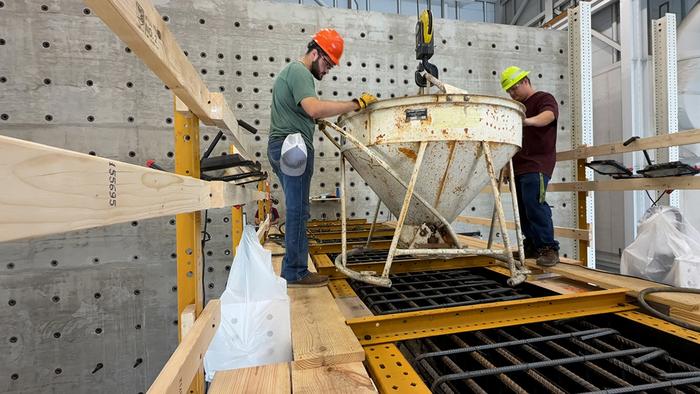
A groundbreaking revolution in bridge construction technology is on the horizon, with a significant project backed by the Texas Department of Transportation (TxDOT) and led by Dr. Kinsey Skillen from Texas A&M University’s Civil and Environmental Engineering Department. This ambitious initiative focuses on optimizing the design and implementation of headed and hooked reinforcement systems within bridge structures, promising to transform the construction landscape across the state of Texas and beyond.
The research project, which has garnered nearly $1 million in funding, spans a considerable duration of 42 months. It represents a collaborative venture between the Texas Transportation Institute and the University of Texas at San Antonio (UTSA). What sets this project apart is its commitment to enhancing the structural performance of bridges while simultaneously reducing construction time and overall costs. This thoughtful approach aims to address the pressing need for more efficient and resilient infrastructure in an era of rapid urbanization and increased vehicular demands.
At the core of this research is the innovative concept of integrating “headed bars” into bridge construction. These specialized reinforcing bars feature a unique nut-like head at one end, designed explicitly to prevent pull-out from concrete structures. This pioneering technique aims to strengthen the joint connections between bridge beams and columns, which are critical structural components that require meticulous engineering and construction considerations to ensure longevity and safety.
The specific type of bridge structure under examination in this study is known as a “straddle bent.” Such structures consist of two large supporting columns and a connecting beam, which together bear the load of elevated roadways. These designs are not only vital for urban infrastructure but also present unique challenges concerning the anchoring of steel reinforcement. Currently, the design process for these joints is intricate and requires extensive considerations, further emphasizing the importance of developing updated guidelines for their construction.
Through comprehensive full-scale experimental testing, the researchers aim to provide TxDOT with revised design provisions that incorporate the use of both hooked and headed bars. These updated guidelines will offer robust insights into the most effective methods of anchoring steel reinforcement, thus enhancing the structural performance and lifespan of future bridge projects.
The ongoing construction of full-scale straddle bent joints using headed bars is taking place at the Center for Infrastructure Renewal’s High-Bay Laboratory. This state-of-the-art facility is specifically designed for large-scale structural testing, providing researchers with the ability to analyze the behavior of reinforced concrete structures under realistic conditions. This research not only advances theoretical understanding but also offers practical applications that can be translated into real-world engineering practices.
Moreover, parallel testing is being conducted at UTSA’s Large-Scale Testing Laboratory under the guidance of Co-Principal Investigator Dr. Adolfo Matamoros. These additional experiments are focused on unraveling the complexities of load transfer mechanisms inherent in both hooked and headed bars. Such knowledge is essential for further refining the application of these reinforcement techniques in diverse Texan bridge scenarios, ensuring that future constructions are built on a foundation of proven engineering principles.
Dr. Kinsey Skillen has established himself as a specialist in large-scale structural testing and is well-versed in the behavior of reinforced concrete structures across various conditions. His extensive research interests encompass field monitoring, steel reinforcement anchorage, enhancement of existing structures, and the applications of ultra-high-performance concrete in construction. His involvement in this groundbreaking project brings an invaluable perspective to the bridge construction industry, combining academic inquiry with real-world engineering challenges.
The implications of this research extend beyond mere cost savings and construction timelines. By fostering a deeper understanding of how headed and hooked reinforcement can be effectively employed, this initiative promises to bolster the safety and resilience of Texas’s transportation networks. As the state grapples with increased traffic demands and construction backlogs, this research could play a pivotal role in addressing these challenges while setting new benchmarks for quality in civil engineering.
Ultimately, the collaboration between Texas A&M University, TxDOT, and UTSA encapsulates a forward-thinking approach to infrastructure development. By harnessing the power of empirical research and innovative construction techniques, they are paving the way for a more efficient and sustainable future in bridge engineering. As these studies continue to unfold, the outcomes will likely influence not just Texas, but potentially provide a blueprint for national and international bridge construction practices.
The wealth of knowledge generated from this research initiative will be crucial for training the next generation of engineers and setting new manufacturing standards in infrastructure development. With the possibility of implementing these findings on larger scales, civil engineers across the globe may one day refer to Texas A&M University’s groundbreaking work when designing the bridges of tomorrow, capable of enduring the test of time and traffic.
Through this project, Dr. Skillen and his team are not merely conducting research; they are fueling a revolution in bridge engineering that champions collaboration, innovation, and efficiency. As they explore the practical applications of headed and hooked bars, the results are anticipated with great interest — a true testament to the power of science and engineering in addressing society’s infrastructure needs.
As we look to the future, it is clear that the work being accomplished in Texas holds significant potential. The endeavor to refine bridge construction techniques represents the evolution of engineering practices that respect time, budget, and safety — pillars on which modern society stands strong and ready to rise to the challenges ahead.
Subject of Research: Enhancement of bridge construction through headed and hooked reinforcement
Article Title: Revolutionizing Bridge Construction: Texas A&M’s Groundbreaking Research
News Publication Date: October 2023
Web References: Texas A&M Engineering
References: Texas Department of Transportation
Image Credits: Texas A&M Engineering
Keywords
Bridge construction, Construction techniques, Environmental methods, Steel, Environmental engineering, Research funding, Educational institutions, Road construction, Laboratories, Scientific approaches, Transportation infrastructure, Reinforced concrete, Torsion.





